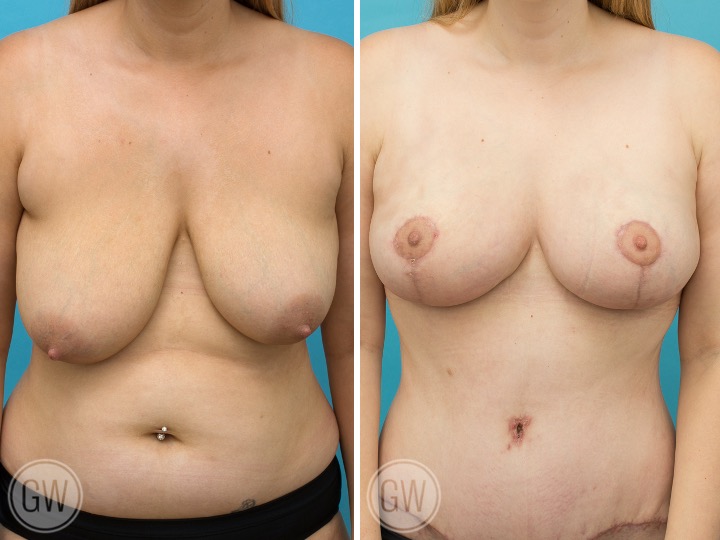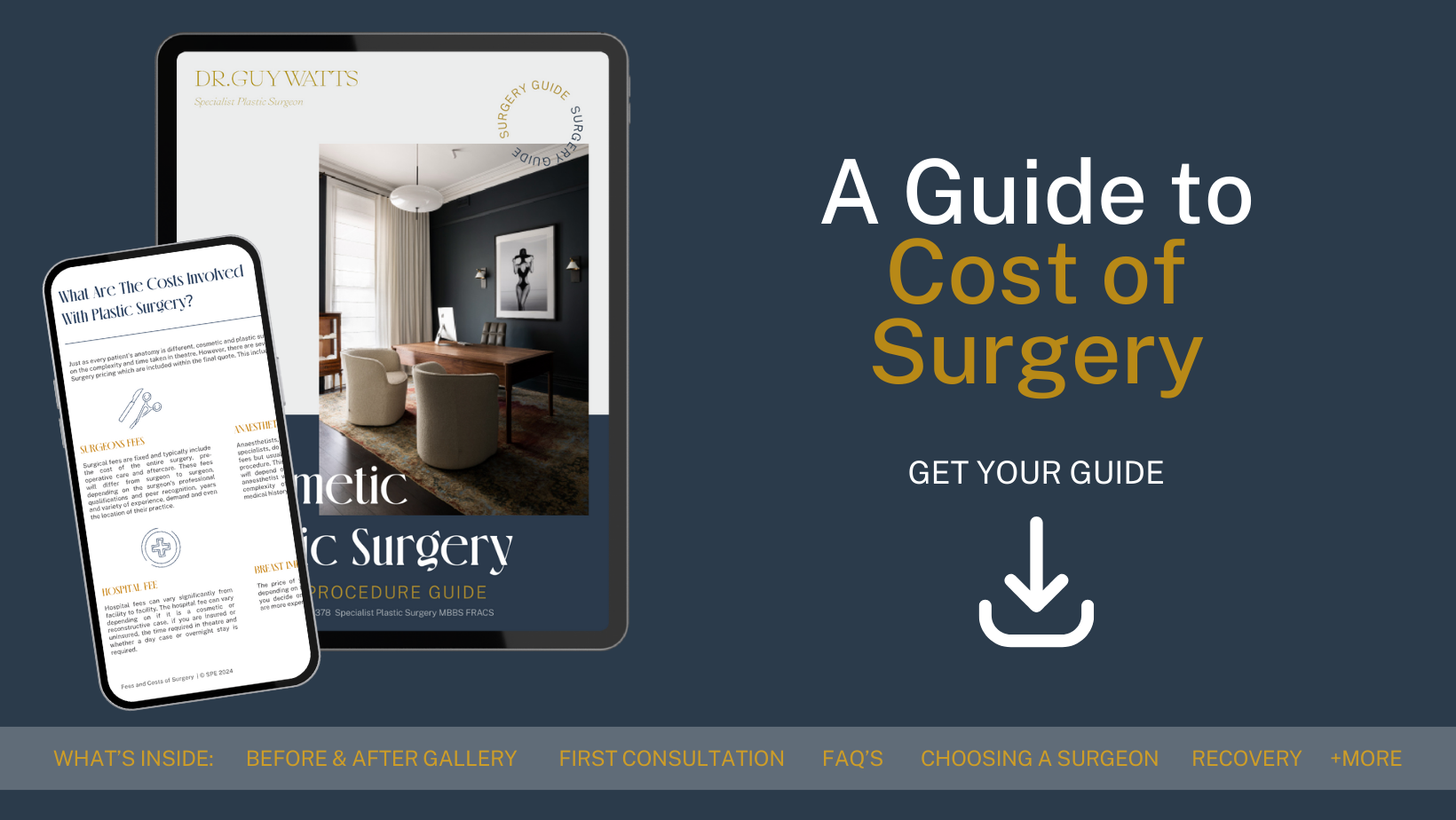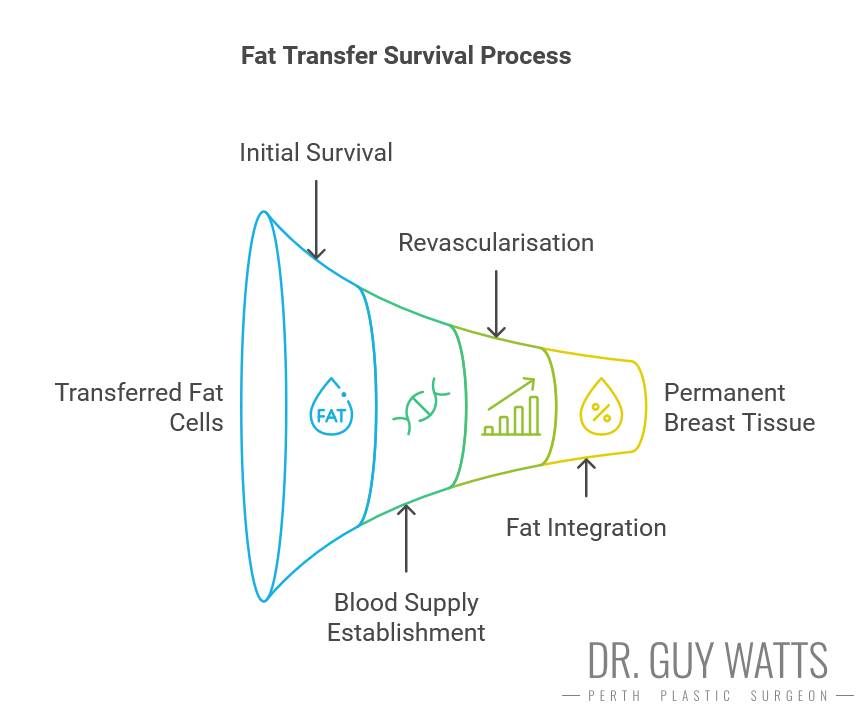
13 Jan How to increase Fat Survival after Fat Grafting Surgery
What to Expect after Fat Grafting to the Breasts Surgery
Fat grafting surgery has become a popular method for breast augmentation, offering optimal results using your body’s fat. However, making sure you have long-term success depends on how well the transplanted fat survives.
Perth Specialist Plastic Surgeon Dr. Guy Watts has many years of experience performing breast procedures, including fat grafting breast augmentation.
Take our quiz, and find out if you are ready for surgery
Fat Grafting to the Breasts – Procedure Overview
Fat grafting to the breasts is a surgical procedure that uses your body’s own fat to increase breast size and shape. It involves harvesting fat from areas with excess deposits, such as the abdomen, thighs, or flanks, through liposuction. The harvested fat is then processed to remove impurities like fluids and oils, leaving only the most viable fat cells for injection.
During the procedure, your surgeon injects the purified fat into specific areas of the breasts using fine cannulas. This process helps shape and increase breast volume. Fat grafting is often chosen by patients seeking a moderate size increase, more symmetry, or reconstruction following mastectomy or lumpectomy.
The procedure requires general anaesthesia and is performed on an outpatient basis. Recovery involves two to three weeks off from work and social commitments.
What Happens to the Fat after It Is Transferred to the Breasts
Once the fat is transferred to the breasts, the healing process begins. The success of the procedure depends on how well the fat cells establish a blood supply in their new location. Initially, some fat cells may not survive due to limited blood flow, which is why surgeons typically transfer more fat than needed to account for this expected loss.
The fat that successfully integrates becomes a permanent part of the breast tissue. The body gradually forms new blood vessels through a process called revascularisation, making sure the transplanted fat receives adequate oxygen and nutrients.
However, not all fat cells survive. Studies show that about 40-60% of the transferred fat typically remains after the healing process. Factors such as smoking, poor circulation, or inadequate postoperative care can negatively affect fat survival. On the other hand, maintaining a stable weight and following your surgeon’s care instructions can significantly contribute to long-term results.
Over time, the breasts may change due to ageing, weight fluctuations, or hormonal changes. Still, the fat that survives after the initial healing period becomes a permanent part of the breast tissue, offering realistic results.
Techniques and Recommendations to Increase Fat Survival
Increasing fat survival after fat grafting surgery involves precise surgical techniques and thoughtful postoperative care. Here are essential methods that help optimise fat retention:
1. Optimal Fat Harvesting and Processing Techniques
Achieving good outcomes in fat grafting begins with how the fat is harvested and processed. Reducing trauma to fat cells is crucial to controlling their survival rate.
- Liposuction Methods: Using low-pressure, advanced liposuction devices reduces the risk of fat cell damage during harvesting. The goal is to extract fat with as little trauma as possible, preserving its structural integrity.
- Careful Handling: Once harvested, fat must be carefully managed to avoid cell rupture. Specific techniques, including sterile processing conditions, help make sure that only good, viable fat cells are prepared for grafting.
- Low-Speed Centrifugation: This method separates viable fat cells from fluids, oils, and damaged cells. By using low-speed centrifugation, your surgeon can make sure that the fat used for transfer is of the highest grade, increasing the chances of long-term success.
- Reducing Exposure to Air: Reducing fat exposure to air during processing decreases the risk of contamination and cell dehydration.
2. Injection Techniques
The injection process plays a critical role in the longevity and appearance of the fat graft. Proper technique helps optimise fat retention and results.
- Small Aliquots Injection: Injecting small amounts of fat at a time helps the grafted fat to remain close to the surrounding tissues’ blood supply. This prevents the formation of fat clumps and increases nutrient absorption.
- Multi-Layered Fanning Technique: This technique involves distributing the fat evenly in a fan-like pattern, maximising tissue contact. Layering the fat allows for better integration and creates a smoother contour.
- Controlled Depth and Placement: Fat must be injected at different depths within the breast tissue to promote integration. Precise placement reduces irregularities and assists with overall breast shape.
- Over-Correction: Surgeons often overfill the treatment area slightly to account for some body absorption of fat cells during the healing process.
3. Recipient Site Preparation
Preparing the recipient site is essential to make sure that the transferred fat survives and thrives. A well-prepared site is more receptive to the graft.
- Good Vascularity: A site with a strong blood supply supports the survival of the fat cells. Preoperative treatments such as external vacuum devices may be recommended to increase vascularity.
- Addressing Pre-existing Conditions: If the site has prior scarring or radiation damage, surgeons may use specific treatments to increase tissue health before the procedure.
- Reducing Tissue Trauma: Reducing trauma during the procedure by using advanced surgical techniques can prevent inflammation and optimise healing.
- Preventing Infection: A sterile surgical environment reduces infection risks, providing an optimal setting for fat graft survival.
4. Postoperative Care
The postoperative phase is critical in determining the success of fat grafting surgery. Proper aftercare helps make sure that grafted fat survives and integrates effectively.
- Avoiding Pressure on the Treated Area: You must avoid direct pressure on the treated areas to prevent fat displacement or damage.
- Following Activity Restrictions: Limiting physical activity during the initial recovery phase helps protect the grafts.
- Maintaining a Stable Weight: Weight stability is essential, as weight fluctuations can alter the appearance of the fat graft results.
- Hydration and Nutrition: Staying hydrated and eating a nutrient-rich diet promotes healing and overall health.
- Regular Follow-Up Appointments: Consistent follow-up visits allow your surgeon to monitor progress and address any concerns promptly.
Factors Affecting Fat Survival
Several factors influence the success of fat grafting procedures, determining how much of the transferred fat survives and integrates into the surrounding tissues. These factors fall into patient-related, surgical, and postoperative care categories.
- Patient’s Overall Health: A patient’s overall health plays a major role in fat survival. Conditions such as diabetes, autoimmune disorders, and circulatory issues can hinder the body’s ability to establish a proper blood supply to the grafted fat. Quitting smoking is crucial, as smoking impairs blood flow and slows the healing process.
- Lifestyle Choices: Maintaining an active, nutritious lifestyle, including regular exercise, a balanced diet, and avoiding alcohol, can promote healing and fat survival.
- Donor Site Selection and Fat Compatibility: The grade of fat harvested from donor sites like the abdomen, thighs, or flanks affects how well the fat survives after transfer. Fat from areas with more stable fat deposits generally have a higher survival rate.
- Hormonal Factors and Weight Stability: Hormonal changes related to pregnancy or menopause can impact long-term fat retention. Maintaining a stable weight is essential, as significant weight fluctuations can cause changes in breast appearance.
- Postoperative Care Compliance: Following all postoperative care instructions, including avoiding pressure on the treated area, staying hydrated, and attending follow-up appointments, can help the longevity of the results.
Expected Results and Long-Term Maintenance
Achieving successful fat grafting results goes beyond the operating room. Long-term maintenance is essential to preserve the appearance of the breasts after surgery.
Realistic Expectations
You should expect some degree of fat reabsorption, especially within the first few months following surgery. Your surgeon might overfill the treatment area slightly to compensate for this loss. Final results become more apparent after about six months.
Weight Management
Maintaining a stable weight is critical. Significant weight gain or loss can impact the appearance of the breasts, as fat cells respond to body-wide changes. Stable weight maintenance helps preserve long-term outcomes.
Lifestyle Choices
Adopting an active, nutritious lifestyle supports fat graft survival. Eating a nutrient-rich diet, staying hydrated, avoiding smoking, and engaging in regular exercise can increase overall health and assist with surgical results.
Regular Follow-Ups
Routine follow-up appointments with your surgeon are essential. These visits allow your surgeon to monitor progress, address concerns, and recommend touch-up procedures if needed.
DOWNLOAD DR WATTS’ GUIDE TO COST OF SURGERY

FAQs about Fat Grafting to the Breasts
How long does it take to see final results?
- Final results typically appear within three to six months after surgery.
- This timeframe allows swelling to subside, and transferred fat to stabilise and integrate with the surrounding tissue.
Can fat transfer be performed with other procedures?
- Yes, fat transfer can be performed alongside other procedures such as mastopexy, abdominoplasty, or liposuction. Make sure to discuss your goals and expectations with your plastic surgeon during the initial consultation.
Is fat transfer permanent?
- Once the transferred fat cells establish a blood supply, they become a permanent part of the breast tissue. However, factors such as weight fluctuations, ageing, and hormonal changes can affect the appearance of the breasts over time.
Will I need multiple fat grafting sessions?
- Depending on the desired volume increase and initial fat survival rate, some patients may require additional fat grafting sessions.
Who is a good candidate for fat transfer?
- Good candidates are individuals with adequate fat deposits in areas like the abdomen, thighs, or flanks. They should be in good overall health, have realistic expectations, and be non-smokers to ensure optimal healing.
How much fat is needed for the procedure?
- The amount of fat required depends on the patient’s goals and current body composition. Your plastic surgeon will harvest more fat than needed due to the expected fat absorption rate after transfer.
Is the procedure painful?
- Fat transfer involves both liposuction and fat injection, which can cause temporary discomfort. Most patients experience swelling, bruising, and mild soreness, which subside within a few weeks.
Can fat transfer alleviate asymmetry?
- Yes, fat transfer can increase breast symmetry by targeting specific areas for precise volume placement.
- More fat can be grafted into one breast to alleviate asymmetry.
What is recovery like after fat transfer?
- Recovery typically involves a few weeks of reduced activity, wearing compression garments, and following specific care instructions.
- Most patients return to daily activities within two to three weeks, though complete healing may take several months.
How long does the procedure take?
- The entire fat transfer procedure, including liposuction and injection, usually takes two to four hours, depending on the amount of fat being transferred and the complexity of the case.
How can I prepare for surgery?
- You should quit smoking, maintain a stable weight, and follow preoperative instructions from your surgeon.
Further Reading about Breast Augmentation Surgery
- Read more about Different Types of Silicone Breast Implants
- Read more about How Can I Enlarge My Breasts?
- Read more about History of Breast Implants
- Read more about What Are the Most subtle Looking Breast Implants?
- Read more about What Is Upper Pole Fullness?
Medical References for How to Improve Fat Survival after Fat Grafting Surgery
- Increasing Facial Fat Graft Survival Using Stromal Vascular Fraction-Enriched Lipotransfer
- A Systemic Review of Autologous Fat Grafting Survival Rate and Related Severe Complications
- The Efficacy of Cell-Assisted Lipotransfer Versus Conventional Lipotransfer in Breast Augmentation
- Survival Mechanisms and Retention Strategies in Large-Volume Fat Grafting
- Large-Volume Fat Grafting to the Breast With External Expansion Assist
About Dr. Guy Watts – MED0001539378
FRACS (Plas) – Specialist Plastic Surgeon In Perth WA
Dr. Guy Watts is a Specialist Plastic Surgeon (AHPRA MED0001539378) with an extensive career that spans across renowned plastic surgery clinics worldwide. His experience has been honed through invaluable experiences at esteemed establishments such as the New York Eye and Ear Infirmary and the renowned Pitanguy Clinic in Brazil.
Having collaborated with the foremost cosmetic plastic surgeons on a global scale, Dr. Watts has chosen to return to Perth after a 17-year journey of intensive training and invaluable professional experience to bring the latest practices and technology in cosmetic plastic surgery to his patients.
Dr. Watts is a Fellow of the Royal Australasian College of Surgeons (FRACS) and a Member of the Australian Society of Plastic Surgeons (ASPS), Australasian Society of Aesthetic Plastic Surgeons (ASAPS) and the International Society of Aesthetic Plastic Surgeons (ISAPS).
Read about the potential Risks and Complications of Surgery
Read the Patient Information and Resources
About CLINISPA
Clinispa is Dr Watts’ bespoke medical clinic performing Cosmetic Aesthetic treatments. At Clinispa, we offer advanced clinical treatments in a luxurious and calming environment, tailored to support your skin’s health and appearance.
Clinispa aesthetic services are performed by Dr Guy Watts’ nursing professionals, who have a passion for and solid understanding of facial aesthetics.
All Clinispa clients are considered individually, with a personalised treatment plan consisting of advanced scientific approaches to cosmetic aesthetics. We incorporate innovative technologies in conjunction with superiorly formulated skin care.
For more information about the full range of Clinispa Aesthetic of Cosmetic Treatments visit the Clinispa website









Sorry, the comment form is closed at this time.